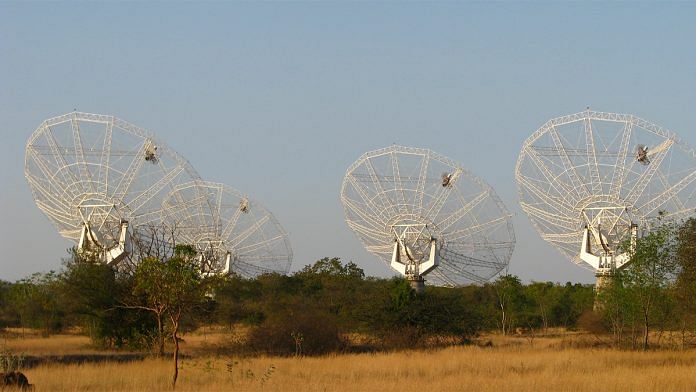Bengaluru: India’s Giant Metrewave Radio Telescope (GMRT) was awarded the IEEE Milestone plaque this week, after it was first selected for the prestigious status in November last year.
The Institute of Electrical and Electronics Engineers (IEEE) is a professional association for electronic engineering and electrical engineering, and rewards the Milestones to achievements that have benefitted humanity.
GMRT is one of the largest radio telescopes in the world and has been operating since 1996. It is located about 80km from Pune and consists of an array of 30 antennas installed over an area of 30 sq km. Sixteen antennas are spread out along the arms of a Y-shaped configuration, while the other 14 are located randomly but close together.
It is operated by the Tata Institute of Fundamental Research (TIFR)-National Centre for Radio Astrophysics (NCRA). The office of NCRA is located in the Savitribai Phule Pune University campus.
Key role in discovery of neutral hydrogen
The telescope is used by experts and astronomers globally. It has played a key role in discovery of neutral hydrogen around other galaxies and supporting international mission to Mass, among other achievements
The facility was constructed under the leadership of the late astronomer Prof. Govind Swarup, who was a pioneer in the field of radio astronomy. He was also the key player behind the design, construction and installation of the Ooty Radio Telescope.
Members of IEEE’s Pune chapter handed over the plaque to Prof. Yashwant Gupta, centre director of NCRA, and Prof. Jayaram Chengalur, the institute’s dean.
”This IEEE Milestone status puts our observatory in a very special league, as there are only a few radio astronomy facilities in the world that have this status,” Gupta told ThePrint.
“It is a moment of great pride and joy for all of us at NCRA; and not just for us, but for the entire scientific and technical community of the country. I am sure that this recognition accorded to the GMRT by the world’s largest body of professionals, the IEEE, will inspire us all to reach even higher levels of achievement in different realms of science and technology in the country,” he said.
Mr. K N Vyas, secretary, Department of Atomic Energy, read out Prime Minister Narendra Modi’s congratulatory note to scientists and engineers at the facility.
It said, “The rare feat by the NCRA-TIFR that has built and runs GMRT has made the nation proud. Our astronomers’ contribution towards a deeper understanding of the celestial phenomenon of the universe has been phenomenal.
“GMRT surely marks a continuation of this magnificent practice as one of the most sensitive radio observatories in the world, which is used by astronomers all over the globe.”
Also read: This fiery bright spot in space is Earth’s first ever image of a black hole’s magnetic fields
3rd Indian facility to get milestone recognition
GMRT has become only the third Indian facility to be accorded the milestone recognition from IEEE.
Previously, it was awarded to J.C. Bose’s demonstration of transmission and reception of radio waves at Presidency College, Kolkata, and then to the discovery of the Raman Effect.
Also under processing and awaiting decision is a nomination for the Calcutta Electric Supply Corporation Limited (1897), which was the first commercial electric supply company in South Asia and brought widespread electricity to the Indian subcontinent.
The IEEE Milestones in Electrical Engineering and Computing programme was established in 1983 to honour achievements in the fields of engineering, computer sciences and information technology, physical sciences, biological and medical sciences, mathematics, technical communications, education, management, and law and policy — with a historic focus on electrical and electronics engineering. It is awarded to projects or achievements that are at least 25 years old and have demonstrated a benefit to humanity.
The process of a milestone approval, from evaluating nominations to casting physical plaques, takes between nine and 15 months.
Also read: Early universe explosion reveals hidden ‘Goldilocks’ black hole that few believed existed



